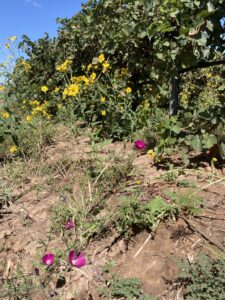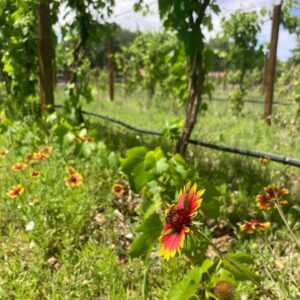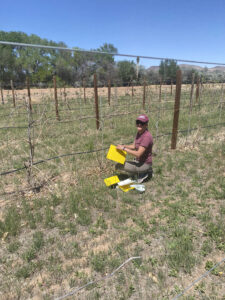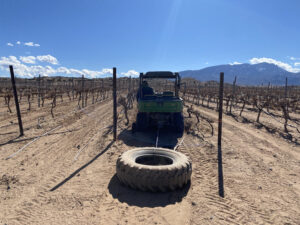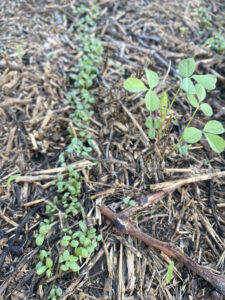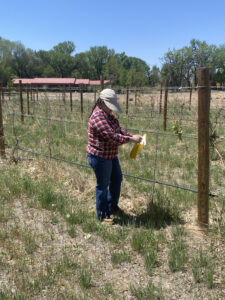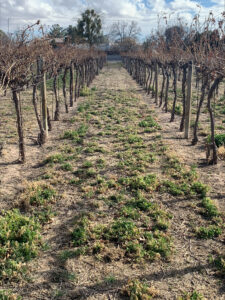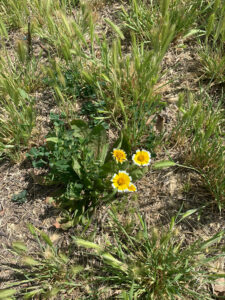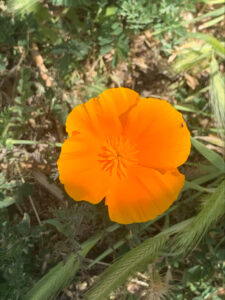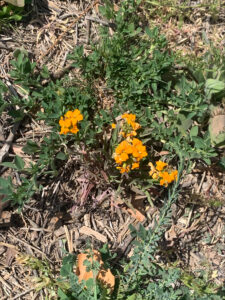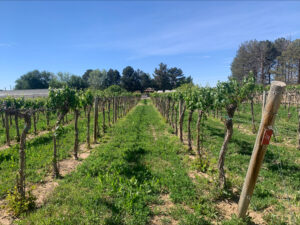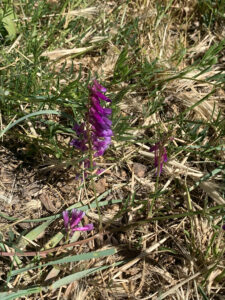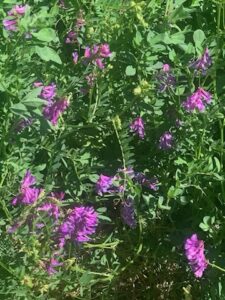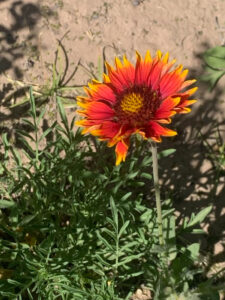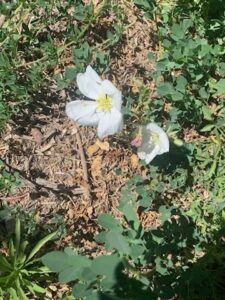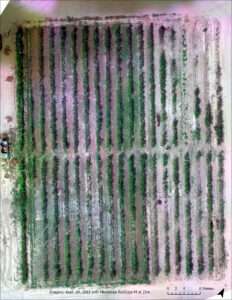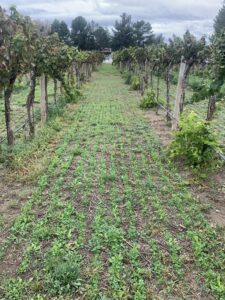Progress report for WRGR21-005
Project Information
Several SARE projects have demonstrated the effectiveness of cover crops on different aspects of vineyard management including optimization of vine growth and performance, pest management, pollinator conservation, and soil health and microbiology, and reduction of soil erosion. The proposed project will build on SARE’s previous projects with the addition of regionally applicable information to establish and enhance habitat for pollinators and natural enemies of insect pests in vineyards and other agricultural sites. The work is located in the semi-arid southwest US, which has been underserved in this area of research despite the growth of the regions’ grape growing industry. Several native plant species that thrive in this region will be used as cover crops. This work accomplishes two of SARE’s program goals: 1) Increasing native habitat to encourage stewardship of natural resources and 2) provide sustainable methods to reduce the need for pesticides for weed and pest control. This project establishes demonstration sites throughout the state with farmer investment, supports workshops, and aids the creation of instructional/informational media and original videos of project impacts and progress.
creation of original videos of project impact and progress. Due to the ongoing pandemic, most work emphasis will be on creating and developing education materials, and conducting several limited attendance workshops. Planted cover crops will remain in place when we are beyond past this current health crisis and growers and researchers can meet in person again.
Objective 1: Establishment of six demonstration plots on 8 acres at experimental and commercial vineyards. Experimental vineyards at NMSU Agricultural Science Centers include Los Lunas Agriculture Science Center, Valencia County, NM (1 ac), and Fabian Garcia Agriculture Science Center, Doña Ana County, NM (3 ac). Commercial vineyards include Pueblo of Santa Ana vineyard, Sandoval County, NM (30 ac, 2 acre dedicated), Lescombes vineyard, Grants County, NM (240 ac, 2 acre dedicated), and Amaro winery vineyards, Doña Ana County, NM (30 ac, 10 acre dedicated).
Objective 2: To increase knowledge and awareness of benefits of cover crops in vineyards in the Southwest
- Short videos on creating habitat, its benefits, and identification of pollinators and natural enemies of pests
- Video and webinar-based training course on “Cover Crops to Enhance Native Pollinators and Manage Insect Pests of Vineyards and Orchards”. The course will be incorporated into existing Pesticide Applicator Training for CEUs.
- Due to ongoing and evolving COVID-19 pandemic regulations and restrictions that impact the ability of face to face group gatherings for the foreseeable future, we will create online resources and conduct a workshop webinar series on cover crop role in vineyard management, pollinator conservation and integrated pest management in vineyards, as well as soil health conservation, and other related topics.
Several SARE projects have demonstrated the effectiveness of cover crops on different aspects of vineyard management including pest management, pollinator conservation, and soil microbiology (8-10). These projects were successful in California and Washington, but were not tested in an arid, desert climate. Similar work has proven the concept in European vineyards (3). We will introduce these cover crop management techniques to grape growers in New Mexico and assess their viability in the southwest. Vineyards produce a high-value specialty crop (wine and/or table grapes), and therefore, are often intensely managed. The agricultural component of the state’s winegrowing industry is modest with approximately 52 commercial producers and 1,100 acres planted. However, the entire New Mexico wine industry, that includes retail and hospitality, generates approximately $4.4 million in federal consumption taxes and $22.2 million in state consumption taxes which include excise and sales taxes (11). Current vineyard practice includes large areas of cultivated soil in the row-middles that is practically bare for most of the year. These exposed areas are subject to wind and water erosion, and the exposed condition is detrimental to much of any native soil microbiome. Our goal is to enhance the sustainability of these vineyard production systems in a resource limited climate that needs careful locally adapted consideration for management techniques.
New Mexico’s pollinator population is one of the most diverse in the United States with over 1,000 species of native bees and over 350 species of butterflies. However, pollinator populations are in decline, threatened by habitat loss, chemical use, and pressure from pests and diseases (12). Cover crops can provide a way to increase the habitat resources (food resources and nesting sites) needed for the conservation of these species (13). Although grapes do not require pollination to thrive, creating a system that supports cover crops and provides diverse agro-ecosystems is important for increasing sustainability. Cover crops provide a stable working “floor” to support human and mechanized vineyard operations, as well as build soil organic matter and reduce soil erosion (5). The same cover crops that support native pollinators and beneficial insects lead to increased ecosystem services and conservation of these species. Cover crops that support beneficial insects may increase biological control of nematode and insect pests in vineyards (14). Flowering cover crops can result in a greater diversity and abundance of bees than weedy vegetation 15). However, native species may be preferable as cover crops in this region, because irrigated non-native cover crops, such as buckwheat, can increase pest populations (16). Furthermore, native plant species often support more native pollinators than non-native plant species, and once established may require less maintenance and resources, especially irrigation water.
Current recommendations often focus on planting a multi-species cover crop mix to best benefit multiple pollinator species (17). Recent research at New Mexico State University has evaluated and ranked several native plants for their attractiveness to beneficial insects. This list of regionally adapted species (18) has not yet been thoroughly demonstrated as to how they can best be incorporated into agricultural settings.
Cooperators
- - Producer (Educator and Researcher)
- - Producer
- (Researcher)
- - Producer (Researcher)
- (Researcher)
Education & Outreach Initiatives
Demonstrate seeding of native species as vineyard cover crops
Explain/describe selected native species cover crops
Demonstrate no-till seeder in vineyard setting
Experienced growers/collaborators at Lescombes and Santa Ana Pueblo vineyards will demonstrate seeding process of the selected seed mix of ~26 native, perennial and annual species in the vineyard row middles. Explain the equipment and the sub-surface drip irrigation to deliver water to facilitate germination and maintenance of the cover crop.
Learning: native species selection, seeding rate and depth, use of the no-till seeder in vineyard setting,
Outcomes: grower exposure to native species most likely to succeed, equipment selection and use, soil preparation/disturbance (minimal) required
1. Seeding and germination video of native species cover crops
2. insect sweeping, collection and field identification of native pollinators occurring in planted vineyard cover crops
- Video. temporally collected and joined to show the seeding, germination and early of growth at two New Mexico vineyards in establishment year
- Video. on-farm and in plot demonstration off field collection and identification of native pollinators in vineyard cover crops at two NM locations.
Participants and viewers will learn at least one method of seeding/establishing vineyard cover crops and how to identify in the field early in the life of the native species cover crops.
Educational & Outreach Activities
Participation Summary:
COMPLETED:
Four (4) Field day tours at NMSU Agricultural Science Centers, Alcalde, Farmington, Las Cruces and Los Lunas (summer 2021)
Three (3) Field day tours at NMSU Agricultural Science Centers, Farmington, Las Cruces and Los Lunas (summer 2022)
Two (2) Field day tours at NMSU Agricultural Science Center, Las Cruces and Los Lunas (summer 2023)
Ten (13) presentations
- @2021 New Mexico Sustainable Agriculture Online Conference - Promoting Beneficial Insects (Dec. 9, 2021)
- Webinar, with Encanto Garden Group Albuquerque (January 2022)
- Workshop, Fabian Garcia Science Center, Las Cruces (February 26, 2022)
- @ Northern New Mexico Fruit Growers - , Abiquiu, NM (March 2, 2022)
- @New Mexico Winegrowers Association Educational Conference, March 15-16, 2022, Los Ranchos Agri-Nature Center, Albuquerque, NM
- Gill Giese and Miranda Kersten – Cover Crops in Vineyards
- Guest speaker, Dr. David James, Washington State University, “ Beauty with Benefits: Naturescaping Washington Vineyards for Biological Control and Biodiversity“
- @2022 NM Agriculture Sustainability Workshop, June 27-29, 2022, Las Cruces, NM – Beneficial Insects
- @ 46th Annual Conferenceof the American Society for Enology and Viticulture-Eastern Section, July 13-15, 2022, Bloomington, MN – Climate, Soil and Phenology of New Mexico Vineyards
- Two (2) presentations @ NM Winegrowers ‘Grape Day’ technical session - Central New Mexico Community College, Albuquerque, NM. July 20, 2022
- Guest speaker - Dr. John Clark – Variety Development and Matching Cultivar to Site
- Gill Giese – Climate Change vs. Vineyards in New Mexico
- @New Mexico Winegrowers Association Educational Conference, February 26-28, 2023, Santa Fe, NM
- Miranda Kersten and Maryel Lopez – Cover Crops in Vineyards
- @National Native Seed Conference, March 27-30, 2023, Washington, D.C.
- Miranda Kersten - Native Habitat Enhancement for Pollinators in New Mexico vineyards
- @47th Annual American Society for Enology and Viticulture Eastern Section Conference, Jun 7-9, 2023, Austin, TX
- Gill Giese - Climate Change vs. Vineyards in New Mexico
- Miranda Kersten - Native Habitat Enhancement for Pollinators in New Mexico Vineyards
- Maryel Lopez - Influence of Cover Crop Planting on Vine Nutrients and Berry Chemistry in a Southern New Mexico Malbec Vineyard
One (1) ACES Magazine article, Agricultural, Consumer and Environmental Sciences NMSU (February 2022), https://aces-about.nmsu.edu/documents/ACESMagazine_SP22_ADA.pdf
One (1) NMSU Newsroom article (August 2022), https://newsroom.nmsu.edu/news/grape-expectations--aes-project-examines-how-cover-crops-can-improve-vineyards-and-pollinator-habita/s/66964fe4-8794-41f9-a95b-1d1c814ede56
One (1) Extension publication, Circular 705: Grape Integrated Pest Management (IPM) in New Mexico, Miranda Kersten and Gill Giese, https://pubs.nmsu.edu/_circulars/CR705/index.html
One (1) Article by Steve Elliott, Western IPM Center (October 2022): http://westernipm.org/index.cfm/ipm-in-the-west/agriculture/planting-cover-crops-in-vineyards-for-ipm-and-soil-health-benefits/
One (1) Video by Steve Elliott, Western IPM Center (October 2022): https://youtu.be/7n4OUsv7Ga4
Five (5) on-farm demonstrations: Lescombes Vineyard, Lordsburg, NM , Santa Ana Pueblo Vineyard, Bernalillo, NM; Noisy Water Vineyard, Rincon, NM; Los Lunas Agricultural Science Center, Los Lunas, NM; Fabian Garcia Agricultural Science Center, Las Cruces, NM (planted spring/summer 2022 with insect collections in summer 2022)
Three (3) on-farm demonstrations: Lescombes Vineyard, Lordsburg, NM , Los Lunas Agricultural Science Center, Los Lunas, NM; Fabian Garcia Agricultural Science Center, Las Cruces, NM (cover crop assessment and insect collection, spring-summer 2023)
IN PROGRESS
One (1) presentation @ conference of northern New Mexico Fruit Growers, Santa Fe, NM (February 2024)
One (1) presentation @ 48th Annual American Society for Enology and Viticulture Eastern Section Conference, 2024, Portland, OR
One (1) presentation @ Virtual National Native Seed Conference, (February 2024)
Three (3) Field day tours at NMSU Agricultural Science Centers, Farmington, Las Cruces and Los Lunas (summer 2024)
Two (2) on-farm demonstrations: Fabian Garcia Agricultural Science Center, Las Cruces, NM and Amaro winery vineyards, La Mesa, NM (continuing cover crop assessment and insect collection, spring-summer 2024)
Learning Outcomes
Project Outcomes
Several farmers have been made aware of methods to achieve possible and potential benefits of cover cropping vineyard row middles in harsh, arid environment. Also farmers and ag professional made aware of number of native pollinators that can be promoted by enhancement of on-farm environment.
Information Products
- Grape Integrated Pest Management In New Mexico (Manual/Guide)
